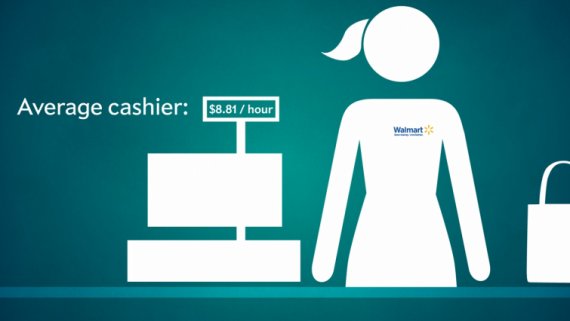The Sad, Slow Death of America’s Retail Workforce
There’s never been a better time to be a consumer. It’s not such a happy story for the people on the shopping floor and behind the counters.

Retail sales just notched their best month since 2012 and the industry has added almost one million jobs since 2010. But the rosy headline stats obscure a more complex and potentially troubling story in retail—particularly for its employees.
The business of selling stuff is becoming much more efficient. Sales-per-employee have gone from $12,00 to $25,000 in the last two decades. That means that even as consumers spend more, we need fewer workers to stock shelves and process orders.
One reason retail has become so efficient is that more of it is happening across Internet cables rather than across registers. E-commerce is gobbling up one percentage point of total sales every two-and-a-half years. Call it the Amazon Effect.
And then there’s the Walmart Effect. As I’ve reported, one Walmart worker replaces about 1.4 local retail workers, so that a county sees about 150 fewer jobs in the years after a Walmart opens its doors. Combined with the Amazon effect, this has dramatically reduced our need for retail workers to sell things, and so retail’s share of the labor force, which peaked in the late 1980s, has been declining ever since.
This isn’t the end of retail. But it is the end of someretail.
According to data obtained by The Atlanticfrom EMSI, the retail industry gained about 49,000 jobs between 2001 and 2013, which means it grew by exactly 0.32 percent. Which means it didn’t grow.
But the major action is at the bookends of this graph below, which shows employment growth in the largest retail subcategories. Department stores, like JCPenney, lost more than 200,000 jobs this century. But supercenters like Walmart, which operates in more than 3,200 domestic locations, added half a million (often lower-paying) jobs.
The death of the salesmen isn’t a uniform trend. It’s spiky. Supercenters nearly doubled their total employment this century. But music stores, photo stores, computer stores, and book stores have been crushed. These used to be services you needed a store to buy. Now they’re apps. (Click this image to enlarge.)
Retail is already a famously low-income industry. According to the Fed, real hourly earnings for retail workers has actually decreased since 2007, the year the recession struck. The upshot is that we’re seeing a large industry stricken by the rise of the Internet, which is growing fastest into supercenters like Walmart that pay regularly low, if not minimum, wages to its employees. For consumers, there’s never been a better time to buy stuff. It’s not such a happy story for the people on the shopping floor and behind the counters
Sourced from theatlantic.com


































Recent Comments